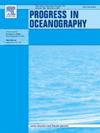哪些过程构成全球远洋生态系统并控制其营养功能?机制模型APECOSM的启示
IF 3.6
3区 地球科学
Q1 OCEANOGRAPHY
引用次数: 0
摘要
远洋生态系统分布在全世界的海洋中。它们具有很强的垂直结构、水平异质性和时间变异性的特点,这对在全球范围内建立它们的模型提出了重大挑战。本文采用高营养水平机制模型APECOSM (Apex predator ECOSystem model),分析了物理和生物地球化学环境对全球远洋生态系统结构和营养功能的制约。为此,我们配置了该模型,以表示六种常见的中上层生物群落的三维和尺寸结构动态:中小型上层生物、热带金枪鱼、中上层摄食金枪鱼、小型沿海中上层生物、中上层居民和中上层洄游者。我们分析了它们在全球范围内出现的三维空间结构。我们首先表明,模拟的水平和垂直分布与观测数据一致。然后,我们分析了关键环境驱动因素的作用,如温度、光、初级生产、电流和氧气对社区反应的影响。最后,我们探讨了远洋生态系统的营养功能,重点关注群落的紧急饮食及其随生物大小的变化。本研究证明了机械生态系统模型能够从一组普遍原则和定义良好的假设出发,代表全球海洋生态系统的多维结构异质性(包括三维分布、大小变化和群落组成)。这种方法有助于理解各种利害攸关的过程如何作用和相互作用,以塑造全球远洋生态系统的结构,并最终阐明其营养功能的异质性。本文章由计算机程序翻译,如有差异,请以英文原文为准。

Which processes structure global pelagic ecosystems and control their trophic functioning? Insights from the mechanistic model APECOSM
Pelagic ecosystems are distributed throughout the world’s seas and oceans. They are characterised by strong vertical structuring, horizontal heterogeneity and temporal variability, which pose significant challenges for modelling them on a global scale. In this paper, we use the mechanistic high trophic level model APECOSM (Apex Predators ECOSystem Model) to assess how the physical and biogeochemical environment constrains the structure and trophic functioning of pelagic ecosystems worldwide.
To this end, we configure the model to represent the three-dimensional and size-structured dynamics of six generic pelagic communities: small and medium epipelagics, tropical tunas, mesopelagic feeding tunas, small coastal pelagics, mesopelagic residents and mesopelagic migrants. We analyse their emergent three-dimensional spatial structuring on a global scale.
We first show that the modelled horizontal and vertical distributions are consistent with the observed data. We then analyse the role of key environmental drivers, such as temperature, light, primary production, currents and oxygen on the response of the communities. Finally, we explore the trophic functioning of pelagic ecosystems, focusing on the emergent diets of communities and their variation with organism size.
This study demonstrates the ability of a mechanistic ecosystem model to represent the multidimensional structural heterogeneity of marine ecosystems globally (encompassing three-dimensional distribution, size variations, and community composition) from a small set of universal principles and well-defined hypotheses. This approach helps to understand how the various processes at stake act and interact to shape the structure of global pelagic ecosystems, and eventually elucidate the heterogeneity of their trophic functioning.
求助全文
通过发布文献求助,成功后即可免费获取论文全文。
去求助
来源期刊

Progress in Oceanography
地学-海洋学
CiteScore
7.20
自引率
4.90%
发文量
138
审稿时长
3 months
期刊介绍:
Progress in Oceanography publishes the longer, more comprehensive papers that most oceanographers feel are necessary, on occasion, to do justice to their work. Contributions are generally either a review of an aspect of oceanography or a treatise on an expanding oceanographic subject. The articles cover the entire spectrum of disciplines within the science of oceanography. Occasionally volumes are devoted to collections of papers and conference proceedings of exceptional interest. Essential reading for all oceanographers.
 求助内容:
求助内容: 应助结果提醒方式:
应助结果提醒方式:


